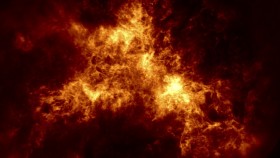Astronomers discover galactic building block
ANU ScienceWise Magazine - Mar/Apr 2007
When the Portuguese explorer Ferdinand Magellan sailed into the southern oceans in the early sixteenth century, he and his crew noticed that alongside the familiar hazy band of faint light extending across the sky were two strange cloud like objects which are known to this day as the large and small Magellanic Clouds. Modern astronomers know these to be dwarf galaxies in orbit around our own galaxy, the Milky Way. The term “dwarf galaxy” conjures up an image of something small and perhaps rather insignificant, but in terms of modern cosmology, nothing could be further from the truth. Astronomers believe that such dwarf galaxies are the fundamental building blocks of the larger spiral and elliptical galaxies that house most of the stars in the universe, including our own sun. Dr Helmut Jerjen of the Research School of Astronomy and Astrophysics, a world authority on dwarf galaxies, describes them as “the bricks that build larger galaxies” and considers them amongst the most intriguing objects in the sky.
Scientists believe that in the early universe space was filled with irregular granular clumps of dark matter interspersed with great quantities of gas and dust. Where the dark matter was densest, it tended to gravitationally draw in the gas and dust, which in turn slowly condensed into many individual stars. Collectively these stars and the dark matter associated with them formed enormous numbers of dwarf galaxies. Over billions of years, these numerous dwarves conglomerated together under gravitational attraction to form the spiral, elliptical and lenticular galaxies that we see today.
Although dwarf galaxies are of such importance to understanding the formation of the universe, there are actually a very limited number of them available to study. Partly because most of them have long since been absorbed into larger galaxies and partly because due to their small size and predominance of dark matter they are relatively dim stellar systems. This means that even the world’s largest telescopes can only detect those that are quite close to us. However whilst observing with the ANU 2.3m telescope at Siding Spring, Dr Jerjen recently made a very surprising discovery. At the edge of his field of view were two galaxies long included in catalogues as large distant objects. To Dr Jerjen’s expert eye, something looked a little odd about one of them. It had a granular transparent appearance more characteristic of a close dwarf than a distant elliptical.
Previously published red shift data showed that the two galaxies were receding from us at roughly 3200km/s, implying a distance of about 60 million light years for both. Nevertheless, Dr Jerjen was having difficulty reconciling this with the appearance of the second object.
When a colleague at the European Southern Observatory (ESO) also became interested, the two decided to investigate further and using the 3.6m large European Southern Telescope (EST) in Chile with its ultra sensitive spectrograph to re measure the red shift of NGC 5011C. Because the spectrograph was able to align its slit along both galaxies simultaneously, the two spectra could be clearly detected and compared with no possibility of confusion or light contamination between them. As Dr Jerjen had suspected, the re measured shift of NGC 5011C was only 650kms-1, reducing it’s distance to 12 million light years, a relative stone’s throw on the universal scale.
As a final confirmation, Dr Jerjen was able to apply a technique that he himself has been instrumental in developing for dwarf galaxies called the surface brightness fluctuation method. In a nutshell, this is a mathematically rigorous and non subjective way to measure how granular or speckled a galaxy looks. Although you can’t resolve individual stars with ground based telescopes, nearby galaxies that are partially resolved appear “lumpier” than distant ones. By quantifying this, it is possible to attach distances to such objects to compliment those obtained by red shift data. When this analysis was applied to NGC 5011C, it confirmed the new spectroscopy data. NGC 5011C was indeed one of those much sought after nearby dwarves.
Astronomers now plan to employ a software package called SAPAC: (Surface brightness fluctuations Analysis Package for the Astronomical Community) created by Dr Jerjen and his PhD student Laura Dunn to analyse 25 Terabytes of imaging data from the new ANU SkyMapper telescope once it is completed in order to search for hundreds of missing dwarf galaxies that are predicted by Cold Dark Matter cosmology.
Dr Helmut Jerjen is leading the Stromlo Milky Way Satellites Survey, a long-term research program with collaborators at Harvard University, the Universities of Bonn, Cape Town, and Michigan that shall resolve an outstanding issue in Cold Dark Matter theory.
Students interested in being involved in this project, please contact Dr Helmut Jerjen.















